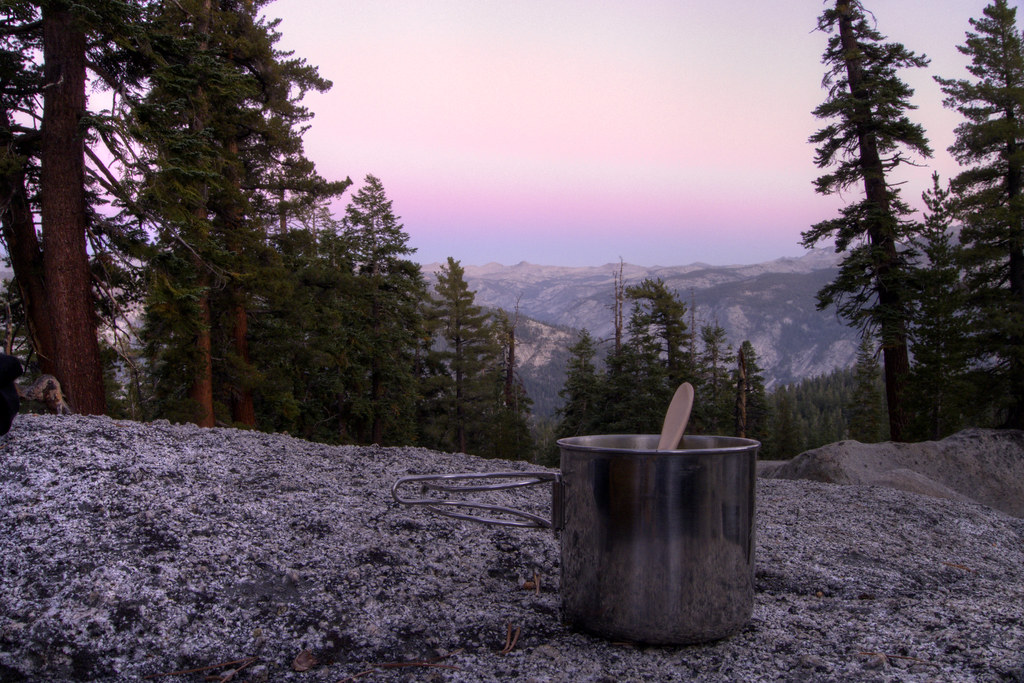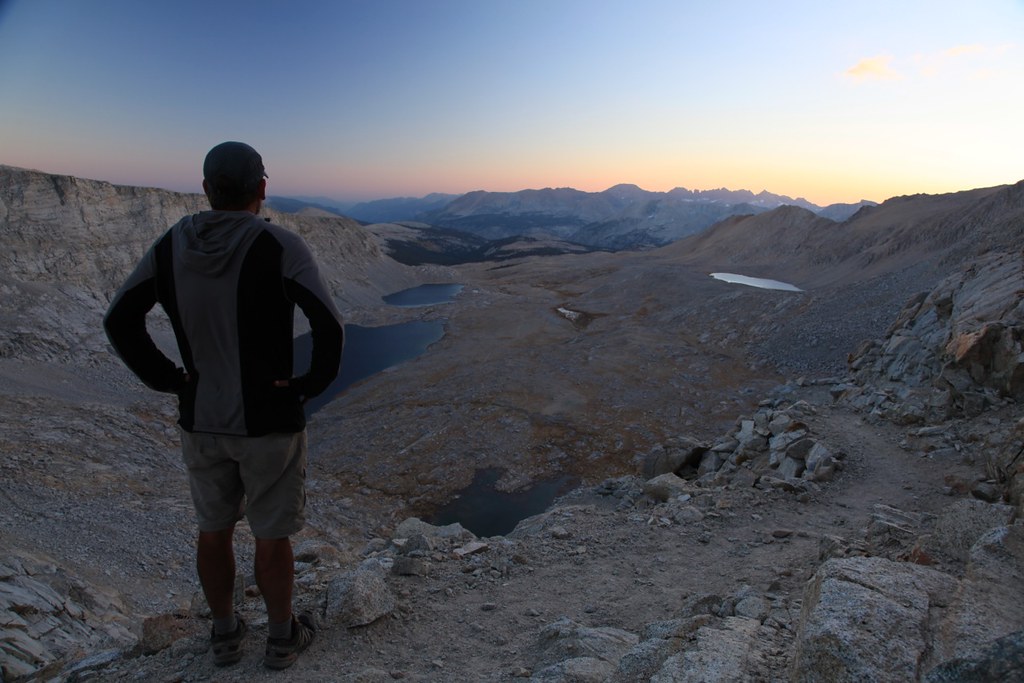Part one will focus on footwear for backpackers and part two will be on foot care and maintenance on the trail, although there will be some overlap. I started my questions with the subject of my previous article, shoes vs. boots.
RG: Possibly the most common footwear debate among hikers is trail runners vs. hiking boots. I prefer, and often recommend to thru-hikers, trail runners with a sturdy wide sole over boots. What are your thoughts? Do you see advantages or disadvantages to either?
PL: Footwear and comfort are highly personal and subjective topics - not just for hiking and sports, but also for daily living. As background, I worked in running shoe stores when I was a podiatry student and I couldn’t understand why people would have such different experiences with the shoes I showed them in terms of comfort.
- "...shoes are like quarterbacks. They get too much credit when things are good and too much blame when things are bad."
-Paul Langer
Research on comfort seems to show that our footwear preferences are influenced by our movement patterns and sensitivity, among other things, which are highly unique person to person. Our bodies are programmed to move in the manner that uses the least amount of energy and causes the least amount of discomfort or pain. No one moves in the exact same way. Our movement pattern is as unique as our signature.
If a shoe works with our movement pattern then it will feel more comfortable. If it works against our movement pattern then it will feel uncomfortable or at least less comfortable than a "better" shoe.
There is also a hierarchy in comfort factors. For example, some people feel that cushioning is of primary importance and arch support or weight are less so. Others might place higher priority on weight and firmer feel. Neither is wrong. In working with athletes and non-athletes, I have learned that unless there is a very specific injury or source of chronic pain that can be addressed by a specific shoe, insole, or shoe modification, I encourage them to trust their instincts on what shoes have the fit and feel that they prefer for the given activity.
Most hikers know their body and feet well and know their preferences. I always respect personal footwear preferences and then try to offer the simplest changes to address pain or injuries as needed.Out of the gate, and I'm rightfully put in my place. Although, it seems to be the conventional wisdom that hikers need boots, so I've noticed new backpackers gravitating toward them by default. Often, because of a belief that a high-collar will offer better ankle support. That seems to make sense, but in practice I don't find them to be very effective. Would ankle wraps do more to protect someone prone to ankle injuries than high-collared footwear?
Yes. Ankle wraps - especially lace-up or Velcro ones are able to provide better ankle protection than high-collared boots.
What footwear do you prefer on the trail?
If a boot were too restrictive at the ankle it would likely cause discomfort there before affecting the hip or knee.Is there any truth to the idea that high-collar boots hinder the development of the support structures inside the ankle?
I've never seen a study that showed high-collared boots inhibit balance or ankle strength long term. In fact, there are no studies that show ankle braces cause this either. Maybe if a person wore their high-collar boots all day, every day, they might have issues, but I would argue that a person who hikes regularly in high-collar boots probably has better balance and strength than a sedentary person who wears flat shoes all day.Alright, I admit I may be trying to reinforce my opinion that trail runners are far superior, but I have one final question about ankle support. A hiker going by the name Trailweaver on WhiteBlaze.net, asks, "I'm now recovered from a severe fracture of the tibia-fibula, but now that ankle swells so much that it's impossible to wear boots (with ankle support) which I always wore before. How do I best protect myself from twisted ankles in low cut shoes? And what should I do about the swelling when I'm hiking?
Unfortunately, after many ankle fractures people develop arthritis. Her swelling is related to the arthritis. I would recommend wearing a compression stocking or adjustable ankle brace that is comfortable. No one can predict how much compression or ankle support is ideal for any given person, so she would need to experiment with different levels of ankle support and find what works for her. She should also be very diligent about doing ankle balance and strength exercises to minimize her risk of re-injury. (Click here to download an exercise sheet provided by Paul that covers foot and ankle exercises)
On a long hike, minimizing swelling early is important because once it starts it can be hard to reduce. On the trail, taking advantage of cold streams can help. Elevating the foot when resting is beneficial as well.
- "I look at footwear as tools and I select the best tool for the given conditions of the trail and how my feet or legs feel."
-Paul Langer
The term "improper footwear" is a controversial one. There is no formal definition and many philosophies on the term. For those with knee or hip pain, I would focus on those joints and then functional movement patterns and core strength, which are more likely contributing to pain than shoes. I've said often, especially in relation to knee, hip, and leg injuries, that shoes are like quarterbacks. They get too much credit when things are good and too much blame when things are bad.It's common practice for long-distance hikers to purchase shoes that are one size larger than you need to accommodate the foot growth that happens on a long-distance hike. Is that good advice to follow? Is this perceived foot growth due to bones growing, arches collapsing, soft tissue swelling, or something else?
There is evidence that cultures who go barefoot or wear only sandals have wider and longer feet in relation to body size, but for thru-hikers it would be unlikely that their feet could grow or expand while wearing footwear that minimizes expansion of bones/joints/soft tissue.
Any perceived change in foot size would be most likely due to soft tissue edema (swelling). If this happens then it would be expected that the feet would return to previous size within a few days or weeks of completing the hike. I haven’t actually seen any research specifically on thru-hikers and foot size, but it would be interesting if we had some data.
I do recommend fitting the boots bigger to accommodate swelling, but not too big. One to 1.5 sizes bigger than street shoes should suffice for most people. In general, I recommend that the boot be snug in the heel and mid-foot to minimize pistoning of the heel and forward slipping on downhills. The boot should allow for wiggle room in the toes to accommodate the swelling. So basically, the boot should be snug in the back two-thirds.HeartFire from WhiteBlaze has a question about insoles. "Do rigid insoles shift your posture or spine?" She said that within 100 miles of switching to rigid Superfeet insoles, she experienced knee pain, shoulder pain, and back pain. When she got rid of them, the problems went away.
For me personally, Superfeet worked great. I started my first long distance hike with minimalist shoes and regretted it after about 400 miles ($1000 x-ray and emergency room visit). On doctor's orders, I switched to a stiffer shoe with rigid Superfeet insoles and my feet improved significantly after only a couple weeks. Are softer insoles better than rigid or is it as subjective as “proper” footwear?
This a very big topic and source of confusion, not just in hiking, but in sports medicine in general. What I always keep in mind, as I mentioned above, is that individual movement patterns are highly unique. In addition, people do not respond in systematic ways to biomechanical interventions. What this means is that prescribing insoles or orthotics (or footwear for that matter) is not like prescribing antibiotics, for example. I can prescribe the same antibiotic to 10 people and expect consistent results in their infection with small variations in side effects. But I can prescribe an insole or orthotic for, let’s say, 10 people with plantar fasciitis and similar foot types and I might get 10 different responses in terms of comfort, pain relief or potential side effects. I explain this to every patient who I speak to about shoes, insoles or orthotics.
My general approach is to do as little as possible to negatively affect their preferred movement pattern, but the problem is that we do not know how a given person will respond, ever. There has been much research done on this topic, which shows that approximately 70% of people respond positively to insoles and orthotics. We do not understand why and the reasons would probably be different person to person anyway.
Benno Nigg, PhD, one of the foremost footwear researchers has said that there is probably an ideal amount of cushioning for each of us in terms of footwear. We just don’t yet know how to determine what that might be. I rarely recommend cushioned insoles for most foot conditions except for older patients who have lost the natural fat pad on the bottom of the foot. For athletes and hikers, semi-rigid insoles like Powerstep, Superfeet and others are better at distributing foot pressure, supporting the arch and being durable enough to hold up.Many backpackers are switching to minimalist footwear. As a barefoot runner and someone injured on the trail due to minimalist footwear, I’d like to know your opinion on this topic. Is it good or bad for the foot? Are there pros and cons?
This is a huge topic. I'll preface this by saying that I run in Vibram FiveFingers, New Balance Minimus, Merrel Trail Gloves, and other minimalist footwear, but I also wear conventional shoes and occasionally insoles and orthotics. I look at footwear as tools and I select the best tool for the given conditions of the trail and how my feet or legs feel. I run more than I hike and I'm lucky enough to live along the Mississippi River, so have miles of grass and parkland right outside my front door.
I love my VFF's for grass runs of up to 8 miles. I probably could condition myself to go longer than that in them but don’t feel the need. For long runs or speed workouts, I use my conventional shoes because I tend to get a bit more beat up. On rocky surfaces or if I'm sore from the previous day's workout, I will also use a more structured shoe or my insoles/orthotics. I spent three years transitioning to VFF's and at one point used them for 50% of my mileage.
Okay, enough about me. I have treated many athletes who have hurt themselves trying barefoot or minimalist shoes. What I find, as far as mistakes made with minimalist shoes, is that people assume that the impact forces of running or hiking magically disappear. They do not - they are merely redistributed. So while knee and hip loading may be decreased, the loads on the calf muscles, Achilles tendons, and metatarsals (long skinny bones of the foot) are increased. This is a big change for most of us who have been using conventional shoes for all of our lives.
Anyone who is interested in trying them needs to do so gradually, listen to their body's feedback and never ignore pain. I give my patients exercises to do to increase strength and flexibility of the calf and Achilles prior to starting (download Paul's exercise pamphlet here). Personally, on very rocky terrain and especially with a pack on my back, I would not likely use my minimalist shoes. I would never say nobody should backpack in minimalist shoes, but I would strongly emphasize a very smart, safe and gradual build up to it - likely over the course of many months or years.One more question about minimalist footwear and I'll move on to the topic of foot maintenance and care on the trail. A minimalist footwear hiker named Meriadoc, from WhiteBlaze.net, has a question about zero drop shoes. "Why are some manufacturers going with a 4 to 5 mm drop in their minimalist shoes?"
He also asks, "When I go on the trail if I push too hard my Achilles starts to ache with a dull pain that gradually increases until it forces me to stop. Why would this happen? Shouldn't my Achilles already be at the full length from walking and hiking in zero drop shoes every day? Is it similar to overuse injuries in the knee tendons?"
The pre-activation and loading of the calf muscles and Achilles tendon complex is higher in shoes with zero drop. Higher heel heights decrease this load. Because we have been using elevated heel design shoes for decades, our bodies need to adapt to the altered load. I don’t know how old Meriadoc is, but if he is over 35 then he is already prone to Achilles tendonopathy because of age related changes to the tendons. He should be doing the eccentric calf muscle exercises I mention above to improve strength and elasticity of the tendon and maybe until he resolves the issue stick to shoes with 4-10 mm of heel elevation. How long should it take to adapt to zero drop? No one can answer that question. It would be highly unique to each individual.In part two, Paul will answer our questions about how to take care of our feet on the trail, and the causes and solutions to many common foot issues.
Related article:
Footcare for Backpackers, Part 2
Should I Buy Hiking Shoes or Boots?
Paul R. Langer, DPM (paullangerdpm.com) is a board certified podiatrist who specializes in sports medicine, foot disorders, biomechanics, surgery and diabetic foot care. He has lectured at and served on the medical staff of international athletic events including the Boston Marathon and China’s Gobi March. He is a clinical advisor for the American Running Association, and an associate of the American College of Foot and Ankle Surgeons. He is the author of Great Feet for Life: Footcare and Footwear for Healthy Aging and has been featured in the following publications:
Athletic Footwear and Orthoses in Sports Medicine
The Big Doctors Book of Home Remedies
Breakthroughs in Drug-Free Healing
Barefoot Running Step by Step
Education: Dr. Langer received his podiatric education at Des Moines University and completed two years of residency and surgical training at the Veterans Affairs Medical Center.
Hospital Affiliations: Fairview Ridges Hospital Fairview Southdale Hospital Minnesota Valley Surgery Center University of Minnesota Medical Center - Fairview
Professional Affiliations and Memberships: American Academy of Podiatric Sports Medicine, President Foot & Ankle Quarterly, Board Member
Special Achievements and Awards: Top Doctor: Voted a top doctor by his peers in Minneapolis/St. Paul magazine (2006 - 2010)
Athletic Footwear and Orthoses in Sports Medicine
The Big Doctors Book of Home Remedies
Breakthroughs in Drug-Free Healing
Barefoot Running Step by Step
Education: Dr. Langer received his podiatric education at Des Moines University and completed two years of residency and surgical training at the Veterans Affairs Medical Center.
Hospital Affiliations: Fairview Ridges Hospital Fairview Southdale Hospital Minnesota Valley Surgery Center University of Minnesota Medical Center - Fairview
Professional Affiliations and Memberships: American Academy of Podiatric Sports Medicine, President Foot & Ankle Quarterly, Board Member
Special Achievements and Awards: Top Doctor: Voted a top doctor by his peers in Minneapolis/St. Paul magazine (2006 - 2010)


com-s.jpg)
com-s.jpg)
com-s.jpg)
com-s.jpg)



